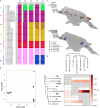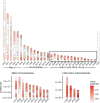Frequent Hybridisation Between Parapatric Lekking Bird-of-Paradise Species
- PMID: 40298045
- PMCID: PMC12100584
- DOI: 10.1111/mec.17780
Frequent Hybridisation Between Parapatric Lekking Bird-of-Paradise Species
Abstract
Hybridisation is known to occur between a wide range of taxa, including species for which strong sexual selection has led to markedly different sexual phenotypes and lek-mating behaviours. To what extent occasional hybridisation can overcome the reproductive barriers in such systems and, for example, lead to the establishment of hybrid zones is poorly known. In this study, we address this question by focusing on one of the most well-known avian radiations in which sexual selection has resulted in an extraordinary assemblage of phenotypic diversity and lek-mating behaviours: the birds-of-paradise (Paradisaeidae). We quantify the genome-wide distribution of introgression and find multiple signals of recent and historical gene flow between and within two genera of birds-of-paradise, Astrapia and Paradigalla. In addition, we present the first empirical genomic indication of a putative hybrid zone between two lekking bird-of-paradise species that differ substantially in their sexually selected traits and behaviours. Our findings are consistent with the idea that behavioural and phenotypic traits may constitute weaker pre- and post-zygotic barriers to gene flow than generally thought in lek-mating species.
Keywords: birds‐of‐paradise; hybrid zone; hybridisation; introgression; lekking; museomics.
© 2025 The Author(s). Molecular Ecology published by John Wiley & Sons Ltd.
Conflict of interest statement
The authors declare no conflicts of interest.
Figures





Similar articles
-
Hybridization in birds-of-paradise: Widespread ancestral gene flow despite strong sexual selection in a lek-mating system.iScience. 2024 Jun 19;27(7):110300. doi: 10.1016/j.isci.2024.110300. eCollection 2024 Jul 19. iScience. 2024. PMID: 39055907 Free PMC article.
-
Contemporary intergeneric hybridization and backcrossing among birds-of-paradise.Evol Lett. 2024 Jun 8;8(5):680-694. doi: 10.1093/evlett/qrae023. eCollection 2024 Sep. Evol Lett. 2024. PMID: 39328285 Free PMC article.
-
Comparative analyses identify genomic features potentially involved in the evolution of birds-of-paradise.Gigascience. 2019 May 1;8(5):giz003. doi: 10.1093/gigascience/giz003. Gigascience. 2019. PMID: 30689847 Free PMC article.
-
Sexual Selection and Introgression in Avian Hybrid Zones: Spotlight on Manacus.Integr Comp Biol. 2021 Oct 14;61(4):1291-1309. doi: 10.1093/icb/icab135. Integr Comp Biol. 2021. PMID: 34128981 Review.
-
Ecology and genetics of speciation in Ficedula flycatchers.Mol Ecol. 2010 Mar;19(6):1091-106. doi: 10.1111/j.1365-294X.2010.04568.x. Epub 2010 Feb 15. Mol Ecol. 2010. PMID: 20163542 Review.
References
-
- Abbott, L. D. , Silver E. A., Thompson P. R., Filewicz M. V., Schneider C., and Abdoerrias R.. 1994. “Stratigraphic Constraints on the Development and Timing of Arc‐Continent Collision in Northern Papua New Guinea.” Journal of Sedimentary Research 64, no. 2b: 169–183. 10.1306/D4267F82-2B26-11D7-8648000102C1865D. - DOI
-
- Andrews, S. 2010. “FastQC: A Quality Control Tool for High Throughput Sequence Data.” [Online]. http://www.bioinformatics.babraham.ac.uk/projects/fastqc/.
-
- Barton, N. H. , and Hewitt G. M.. 1985. “Analysis of Hybrid Zones.” Annual Review of Ecology and Systematics 16, no. 1: 113–148. 10.1146/annurev.es.16.110185.000553. - DOI
-
- Beehler, B. M. , and Pratt T. K.. 2016. Birds of New Guinea: Distribution, Taxonomy, and Systematics (REV‐Revised). Princeton University Press. https://www.jstor.org/stable/j.ctt17xr52d.
MeSH terms
Grants and funding
LinkOut - more resources
Full Text Sources

